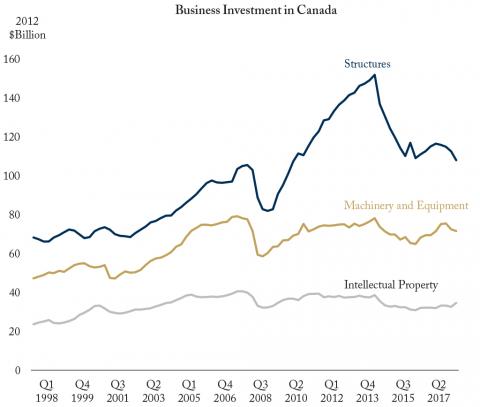To: Canadian Workers
From: William B.P. Robson
Date: March 11, 2019
Re: You Need Better Tools to Compete
For economists and traders, Statistics Canada’s release of data on gross domestic product earlier this month is already old news. GDP barely rose – 0.1 percent in the fourth quarter of 2018. So the Bank of Canada would not hike the overnight rate, which it did not. And last week’s strong jobs report reassured us that we’re not tipping into recession. So on we go.
For all Canadians with jobs, however, StatCan’s numbers carried another message, more troubling than the marginal increase in GDP. Business investment fell sharply in the fourth quarter of 2018 – down 11 percent at an annual rate in real (inflation-adjusted) terms – and finished the year more than 4 percent below its level a year earlier. The biggest component, structures such as buildings and engineering, fell at a 15 percent annual rate. Machinery and equipment was off nearly 5 percent. Investment in intellectual property was up on the quarter, but the overall picture was profoundly disappointing at a time when unemployment is low, the economic cycle is mature, and Canadian workers need gains in incomes that only productivity-boosting investment can secure.
Short-term concerns about quarterly GDP growth aside, weak business investment is a long-term threat to Canada’s prosperity. Additions to Canada’s stock of buildings, equipment and other physical capital, and intangibles such as computer software, machinery, buildings, engineering infrastructure and intellectual property equip Canadian workers to raise their output, compete in the world economy, and earn higher incomes.
During the decade before the financial crisis and recession of 2008-09, Canada’s record on business investment was relatively good. With supportive tax policies and trade liberalization, our per-worker performance was good enough to narrow long-standing gaps between us and the United States and other developed countries. After the slump a decade ago, investment in structures – much of it related to a boom in the energy sector – continued Canada’s relatively good performance (see Figure).
In 2014, however, that all changed. Lower oil prices, fears – some realized – of US protectionism, and more burdensome and unpredictable regulation – especially in the energy sector –all weighed on our performance. The most recent figures show investment in structures barely above its pre-crisis peak, while investment in machinery and equipment, and investment in intellectual property, are lower than they were in 2007. With employment up more than 10 percent since then, the average Canadian worker is getting far less new capital to work with.
The list of problems holding investment back is long. Although the federal government moved to allow faster write-offs of many kinds of equipment last fall, relatively high taxes on earnings and property make potential investors think twice. Protectionism in the United States and other trading partners increases the need for Canada to reduce frictions at the border and promote freer trade at home. Policies that are throttling the fossil fuel sector and raising electricity prices need to change. And governments need to hit pause on regulations outside the energy sector that delay projects, impede access to capital, and tilt businesses toward locating top talent and operations outside Canada.
The list of problems may be long, but the rewards from tackling it are big. Not that many years ago, businesses in Canada were investing robustly, not just adding to the tools their workers used year by year, but improving their workers’ position against competitors abroad. We can raise our game again. For the sake of our future prosperity, we must.
William B.P. Robson is CEO of the C.D. Howe Institute.
To send a comment or leave feedback, email us at blog@cdhowe.org.
The views expressed here are those of the author. The C.D. Howe Institute does not take corporate positions on policy matters.






